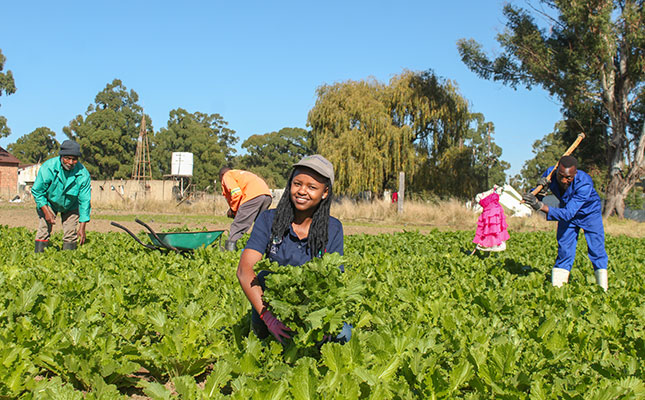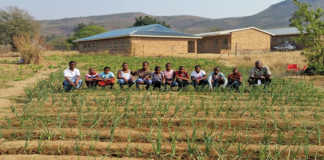
Photo: FarmSol
Industrialised agriculture aims for high yields in order to deliver low-cost food to consumers. As such, it is mostly a corporate endeavour, and excludes smaller producers. Moreover, it stands accused of contaminating soil and water with excessive use of chemical fertilisers, pesticides and herbicides, and creating antimicrobial resistance.
In contrast, regenerative farming takes a conservation and rehabilitation approach to food and farming systems, explains Alan Rosenberg, owner of Lindros Whole Earth Consultants, which specialises in agroecology.
Where conventional farming usually focuses on monoculture and maximum yield, regenerative agriculture targets the creation of relationships, such as those between plants and animals, and between soil microbes and plant roots.
Conservation agriculture (CA) and regenerative agriculture (RA) are two approaches to sustainable farming. CA is based on three principles: minimum tillage and soil disturbance, biological diversity through crop rotation, and maximum soil cover.
“RA is based on these same principles, but also focuses on ‘living roots’ and the integration of livestock,” explains Dr Johann Strauss, senior scientist in sustainable cropping systems research at the Western Cape Department of Agriculture.
One of South Africa’s most prominent regenerative farmers is Danie Slabbert, who produces maize, potatoes and soya bean near Reitz in the eastern Free State. In 2008, he began practising CA on a piece of land by means of no-till, and over time has converted 1 300ha to RA.
“From the start, I noticed less erosion and better water penetration. Later, I introduced the high-density grazing of cattle and sheep, as well as multispecies cover crops to protect the soil.
“I also began to use fewer chemicals and fertilisers, and saw how life returned to the soil. What’s more, my biggest harvest ever was from an RA land,” Slabbert says proudly.
No-till and soil health
Healthy soil is rich in organic matter, as well as microbes that break down this organic matter, causing the release of nutrients into the soil in a form that can be assimilated by plants. If the soil is healthy, the farmer will be less reliant on fertiliser.
“RA aims to regenerate the natural ecosystems within the soil. By implementing these practices, farmers can reduce their [need for] chemical inputs and thus lower their collective carbon footprint,” explains Strauss.
Aron Kole, managing director of agricultural services company FarmSol, stresses that by building up soil health, farmers are investing in their future harvests, as well as future generations.
“Farming is a long-term investment in the feeding of multiple generations. This can only be achieved if the soil is protected by working on it sustainably,” he says.
FarmSol helps to commercialise emerging farmers by providing them with technical support, as well as sourcing agricultural production loans to enable them to grow grain crops.
“Funders of these loans want to see that their investments are having a positive impact on the environment, and in this regard smallholder farmers can make a crucial contribution to sustainable agriculture,” adds Kole.
And while producers who farm on rented land might not feel inspired to invest in soil that isn’t theirs, Minky Kgopa, who farms maize and sunflower near Kaalpan in North West, does exactly that.
“The short-term rental of farmland can be limiting and discouraging when it comes to caring for the soil, but healthy soil leads to healthy crops and better yields. Soil health is as vital to crops as oxygen is to humans,” she emphasises.
Kgopa started implementing RA principles in 2019 on her 110ha of rented land, and has already noticed the difference.
“The camp on which we left crop residue from the previous season showed better water retention than the camp that was left bare,” she explains.
Cover crops and regenerative grazing
In no-till systems, plant residue is left on the soil, leading to improved water infiltration and a reduction in the loss of soil to wind erosion. No-till is therefore a step towards RA, but to optimise the regeneration of their soil, farmers are encouraged to add organic matter to it.
In addition, planting cover crops and incorporating livestock farming can help to reinvigorate the biology of the soil. Cover crops such as tillage radish aerate the soil and reduce compaction, while cover crop mixes that contain legumes, such as clover and vetch, also attract beneficial insects, can be used for animal feed, and help fix atmospheric nitrogen in the soil for use by the following crop.
A key facet of RA is regenerative grazing, also referred to as adaptive multi-paddock (AMP) grazing. Here, large numbers of livestock graze small areas for short periods. With such a high stocking density, the cattle crush the weeds effectively and scatter the manure, thereby fertilising the soil.
And because the grazing period is brief, the cover crops are grazed down by less than 50%, which means they don’t lose too many roots and can therefore recover far faster.
Benefits and challenges
The effects of RA are not usually obvious in the first year, as most of the important work is taking place within the soil. Greater levels of biodiversity both above and beneath the soil surface bring about new cycles of insect pest and predator populations, as well as nutrient assimilation in plants.
The structure of the soil is also improved and, as a result, so is its water-holding capacity, which reduces the leaching of nutrients. This, in turn, lowers the input costs of fertiliser and water.
On a social level, small-scale farmers are learning about RA from commercial producers at farmers’ days, and this is helping to improve rural development.
RA nevertheless comes with its own set of challenges. One of these is the almost complete lack of government incentives for it in South Africa. Farmers who are keen to improve soil health must forge ahead themselves.
Rosenberg therefore believes that by collaborating with and supporting one another, both small-scale and commercial producers will be better equipped to introduce RA practices on their farms.
He adds that while educating staff on new farming techniques and training them on the importance of looking after the environment require time and patience, they are absolutely necessary.
The first step
So where do you start?
By bringing an end to ploughing?
Planting cover crops?
Implementing AMP grazing?
“Look at your soil and identify its limiting factors. Are there compacted layers or deficiencies? If so, you’ll need to correct these before you start. Next, plan a crop-rotation system and decide if you want to incorporate livestock or simply focus on crops,” advises Strauss.
Rosenberg also recommends focusing on the soil, and says the best way to feed a plant is by feeding the soil first. He also proposes crop diversification.
Kgopa suggests obtaining a full soil profile: “Invest in acquiring a comprehensive view of soil nutrients and the entire soil horizon. Then follow a crop-specific fertigation plan based on the results of the soil analysis.”
For farmers who rent land, acquiring data on soil condition is useful in planning for future seasons, she adds.
According to Kole, FarmSol farmers in the Western Cape have had outstanding results with crop rotation, alternating barley, wheat, canola and oats.
“In the central production areas, farmers rotate crops such as soya bean, barley, sunflower and maize on different lands. Crop performance has been outstanding, and the farmers are reaping the financial rewards, too,” adds Kole.
Slabbert’s advice is to be patient. RA, he emphasises, isn’t a quick fix. However, the satisfaction that comes with seeing the resultant positive changes is immense. In addition to taking time, RA requires that farmers make changes to their management systems, as well as their thinking. However, it is absolutely necessary to sustaining the health of their soil. And this, in turn, is crucial to food production and security.
Email Alan Rosenberg at [email protected], Dr Johann Strauss at [email protected], Aron Kole at [email protected], or Minky Kgopaat [email protected]. Phone Danie Slabbert on 082 339 9018. Visit farmsol.co.za.











